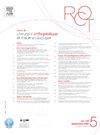简单髋关节值:髋关节评估的简单评分
Q4 Medicine
Revue de Chirurgie Orthopedique et Traumatologique
Pub Date : 2024-10-28
DOI:10.1016/j.rcot.2024.07.014
引用次数: 0
摘要
背景Plusieurs autoquestionnaires évaluent la fonction de la hanche en pratique clinique (HOOS-12, Oxford-12)。然而,其使用却很复杂。最近的研究表明,一个独特的问题可以有效地评估发音功能。我们开发了 SHV(简单髋关节值)测试,这是一个允许患者评估其髋关节功能(0 至 100)的问题。我们进行了一项前瞻性研究,以评估 SHV 测试与 Oxford-12 和 HOOS-12 评分的相关性,并评估该测试的辨别能力和再现性。患者和方法我们在 2020 年 11 月至 2021 年 4 月期间在本中心纳入了 74 名接受过总体血压测量的患者。手术后 18 个月对 SHV、HOOS-12 和 Oxford-12 进行测试,测试结果均为 100 分。为评估测试的再现性,在该组中选择了 20 名患者进行了包含这 3 份问卷的第二次测试。为了评估该测试的辨别能力,我们选择了 20 名患者回答三份问卷。结果显示,SHV 的评分为 90.0(四分位数间距 [IQR]:80.0;95.0),Oxford-12 为 88.5(四分位数间距:77.1;95.8),HOOS-12 为 79.1(四分位数间距:65.1;93.2)。SHV与Oxford-12(斯皮尔曼系数:0.63)和HOOS-12(斯皮尔曼系数:0.66)高度相关。SHV 与对照组差异显著(对照组为 90,0 vs 100,0; p < 0,001),并具有极好的再现性(CCI:0.82):DiscussionLe SHV est un outil fiable, reproductible et discriminant pour évaluer la fonction de la hanche après la pose d'une prothèse totale de hanche, offrant ainsi une approche simplifiée et pratique pour les praticiens.Niveau de preuveIII ; étude prospective comparative diagnostique.BackgroundSeveral self-administered questionnaire are available for assessing hip function in clinical practice (HOOS-12, Oxford-12)。这些问卷可用于评估和监测髋关节病变患者。然而,在临床实践中有时很难使用这些问卷。最近对肩关节和膝关节的研究表明,单个问题的评估可提供相关的关节功能评估,并与更复杂的评分相关联。然而,我们尚未对髋关节进行评估。我们的目标是开发一种单题测试,让患者能够在 0 到 100 之间评估自己的髋关节功能。因此,我们进行了一项前瞻性研究,旨在评估1) 通过与牛津-12 和 HOOS-12 评分进行比较,评估 SHV(简单髋关节值)测试的相关性;2) 该测试的判别能力和可重复性。患者和方法我们进行了一项前瞻性研究,研究对象包括 2020 年 2 月至 2021 年 4 月期间在一家高流量中心接受全髋关节置换手术的 74 名患者和 20 名健康受试者。平均在手术后 18 个月提交 SHV 问卷以及 HOOS-12 和 OXFORD-12,测试值为 100 分。为了评估测试的再现性,我们从髋关节置换术组中随机抽取了 20 名患者,再次进行了包含这 3 份问卷的测试。结果SHV、Oxford-12和HOOS-12得分的中位数分别为90/100(四分位距[IQR]:80-95)、88.5(IQR:77.1-95.8)和79.1(IQR:65.1-93.2)。SHV与Oxford-12(斯皮尔曼系数:0.63 [IQR:0.45-0.76])和HOOS-12(斯皮尔曼系数:0.66 [IQR:0.46-0.79])密切相关。讨论SHV测试似乎是评估全髋关节置换术后髋关节功能的一种可靠、可重复和有鉴别力的工具,因此为从业人员提供了一种简化和实用的方法。在不同人群中进行进一步测试将有助于验证该测试的有效性。本文章由计算机程序翻译,如有差异,请以英文原文为准。
Simple Hip Value : un score simple pour l’évaluation de la hanche
Contexte
Plusieurs autoquestionnaires évaluent la fonction de la hanche en pratique clinique (HOOS-12, Oxford-12). Cependant, leur utilisation est parfois complexe. Des études récentes ont montré qu’une question unique peut évaluer efficacement la fonction articulaire. Nous avons développé le test SHV (Simple Hip Value), une question permettant aux patients d’évaluer leur fonction de hanche de 0 à 100. Nous avons mené une étude prospective afin d’évaluer la pertinence du test SHV en le comparant aux scores Oxford-12 et HOOS-12, et d’évaluer la capacité de discrimination et la reproductibilité de ce test.
Hypothèse
L’évaluation de la fonction de la hanche par un questionnaire rempli par le patient (PROM) à question unique est fiable et utile dans la pratique clinique.
Patients et méthodes
Nous avons inclus 74 patients ayant reçu une prothèse totale de hanche entre novembre 2020 et avril 2021 dans notre centre. Le SHV, HOOS-12 et Oxford-12 ont été administrés 18 mois après la chirurgie, avec des valeurs ramenées sur 100 points. Un deuxième test contenant les 3 questionnaires a été resoumis à 20 patients choisis aléatoirement dans ce groupe pour évaluer la reproductibilité du test. Pour évaluer la capacité de discrimination de notre test, 20 témoins ont été sélectionnés pour répondre aux trois questionnaires.
Résultats
Les résultats ont montré des scores médians de 90,0 (interquartile range [IQR] : 80,0 ; 95,0) pour le SHV, 88,5 (IQR : 77,1 ; 95,8) pour le Oxford-12 et 79,1 (IQR65,1 ; 93,2) pour le HOOS-12. Le SHV était fortement corrélé avec le Oxford-12 (coefficient de Spearman : 0,63) et le HOOS-12 (coefficient de Spearman : 0,66). Le SHV différait significativement du groupe contrôle (90,0 vs 100,0 dans le groupe contrôle ; p < 0,001) et avait une excellente reproductibilité (coefficient de corrélation interclasse (CCI) : ICC : 0,82).
Discussion
Le SHV est un outil fiable, reproductible et discriminant pour évaluer la fonction de la hanche après la pose d’une prothèse totale de hanche, offrant ainsi une approche simplifiée et pratique pour les praticiens.
Niveau de preuve
III ; étude prospective comparative diagnostique.
Background
Several self-administered questionnaires are available for assessing hip function in clinical practice (HOOS-12, Oxford-12). These questionnaires can be used to assess and monitor patients with hip pathology. However, they are sometimes difficult to deploy in clinical practice. Recent studies on the shoulder and knee have shown that a single-question assessment provides a relevant evaluation of joint function, and correlates with more complex scores. However, this has not yet been evaluated for the hip. We set out to develop a single-question test that would enable patients to assess their hip function between 0 and 100. Therefore, we did a prospective study aiming to assess: 1) the relevance of the SHV (Simple Hip Value) test by comparing it with the Oxford-12 and HOOS-12 scores; 2) the discriminatory capacity and reproducibility of this test.
Hypothesis
The hypothesis of this study was that the assessment of hip function by a single-question patient-completed questionnaire (PROM) would be reliable and useful in clinical practice.
Patients and methods
We conducted a prospective study including 74 patients operated on for total hip arthroplasty from February 2020 to April 2021 in a high-volume center and 20 healthy subjects. The SHV questionnaire, as well as HOOS-12 and OXFORD-12, were submitted on average 18 months after surgery, with values scaled to 100 points. A second test containing the 3 questionnaires was resubmitted to 20 patients randomly chosen from hip arthroplasty group to evaluate the reproducibility of the test. To evaluate the discrimination capacity of our test, 20 controls were selected to respond to the three questionnaires.
Results
Test results were median SHV, Oxford-12 and HOOS-12 scores of 90/100 (interquartile range [IQR]: 80–95), 88.5 (IQR: 77.1–95.8) and 79.1 (IQR: 65.1–93.2), respectively. The SHV was strongly correlated with the Oxford-12 (Spearman coefficient: 0.63 [IQR: 0.45–0.76]) and the HOOS-12 (Spearman coefficient: 0.66 [IQR: 0.46–0.79]). The SHV differed significantly from the control group (90.0 vs. 100.0 in the control group (p < 0.001)) and had excellent reproducibility (Interclass Correlation Coefficient [ICC]: ICC: 0.82 [CI95%, 0.59–0.93]).
Discussion
The SHV test seems to be a reliable, reproducible and discriminating tool for assessing hip function after total hip arthroplasty, thus offering a simplified and practical approach for practitioners. Further testing in different populations would be useful to validate this test.
Level of evidence
III; prospective comparative diagnostic study.
求助全文
通过发布文献求助,成功后即可免费获取论文全文。
去求助
来源期刊

Revue de Chirurgie Orthopedique et Traumatologique
Medicine-Surgery
CiteScore
0.10
自引率
0.00%
发文量
301
期刊介绍:
A 118 ans, la Revue de Chirurgie orthopédique franchit, en 2009, une étape décisive dans son développement afin de renforcer la diffusion et la notoriété des publications francophones auprès des praticiens et chercheurs non-francophones. Les auteurs ayant leurs racines dans la francophonie trouveront ainsi une chance supplémentaire de voir reconnus les qualités et le intérêt de leurs recherches par le plus grand nombre.
 求助内容:
求助内容: 应助结果提醒方式:
应助结果提醒方式:


